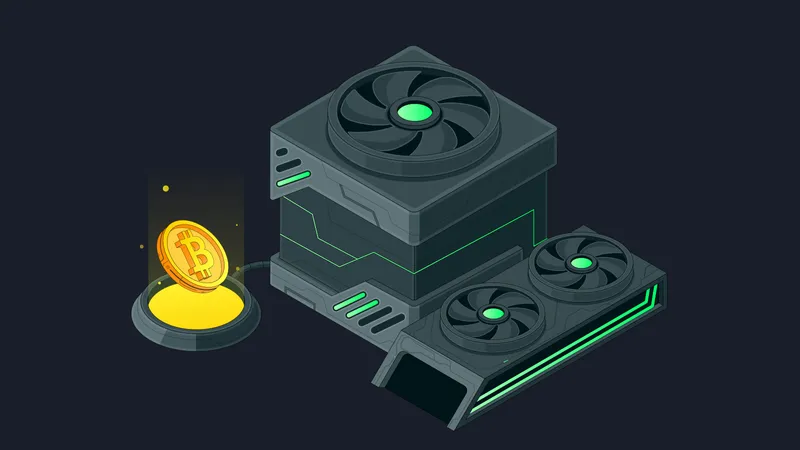Understanding the Basics: What is Cloud Mining?
Cryptocurrency mining was once the exclusive domain of tech enthusiasts, demanding expensive specialized hardware, immense power consumption, and advanced maintenance skills. However, with the popularization of Bitcoin and other cryptocurrencies, a new, accessible way to participate emerged: Cloud Mining.
Simply put, what is cloud mining? Cloud mining explained is the process of remotely participating in cryptocurrency mining by leasing computing power (hashrate). You do not need to purchase, set up, or maintain any physical mining rigs yourself. Professional cloud mining companies own and operate large data centers (mining farms), and you purchase a contract to share in the cryptocurrency profits generated by these farms. This makes it possible for anyone, regardless of their technical background or location, to become a cryptocurrency miner. For an even more comprehensive overview, refer to Cloud Mining: Everything You Should Know.

Cloud Mining vs. Traditional Mining: The Fundamental Difference in Operation
To understand what is cloud mining and how it works, we must first compare it with traditional mining (Hardware Mining).
td {white-space:nowrap;border:0.5pt solid #dee0e3;font-size:10pt;font-style:normal;font-weight:normal;vertical-align:middle;word-break:normal;word-wrap:normal;}
| Feature | Traditional Mining (Hardware Mining) | Cloud Mining (Cloud Mining) |
| Hardware Requirement | Must purchase and own ASIC or GPU miners. | No hardware purchase required; only hashrate is leased. |
| Maintenance & Operations | Miner handles hardware setup, cooling, noise, electricity, and troubleshooting. | Entirely managed by the cloud mining provider. |
| Initial Investment | Extremely high (cost of miners, equipment, setup space). | Relatively low (only the cost of the hashrate contract). |
| Electricity Cost | High electricity bills are borne by the miner. | Included in the daily "Maintenance Fee." |
Cloud mining significantly lowers the barrier to entry, resolving the pain points of traditional mining such as noise, heat, high power consumption, and maintenance. Therefore, the core difference in what is cloud mining vs traditional mining is that all complex and high-cost operational work is outsourced.
Deconstructing Cloud Mining: Understanding Cloud Mining Types and Hashrate
Cloud mining services are typically categorized into two main types, each carrying different levels of risk and control:
Hashrate Leasing (Hosted Hashrate)
This is the most common of the cloud mining types.
-
How it Works: You purchase a specific amount of hashrate (e.g., 10 TH/s or 100 MH/s). You do not own the hardware but rent the computing power produced by that hardware for the contract duration.
-
Profit Distribution: The platform distributes the mined coins proportionally to your leased hashrate relative to the pool's total hashrate (minus maintenance fees).
-
Best for: Individuals seeking purely passive income who want zero involvement in technical operations.
Hosted Mining (Dedicated Rig Hosting)
-
How it Works: You purchase and own one or more physical mining rigs, which are then hosted at the service provider's professional farm. The provider manages and operates the rigs, but you retain hardware ownership.
-
Profit Distribution: You receive all the output of your rigs (minus hosting fees and electricity costs).
-
Best for: Intermediate users who want asset ownership (the miner) but lack the operational environment and professional maintenance capability.
The cloud mining hashrate is the unit used to measure your mining speed. A higher hashrate means a greater mining contribution and, thus, a larger share of the reward. Before purchasing a contract, clearly understand the hashrate unit, quantity, and the algorithm (e.g., SHA-256 for Bitcoin, Scrypt for Litecoin/Dogecoin).
In-Depth Analysis: Cloud Mining Pros and Cons
While convenient, cloud mining is not without its drawbacks.
td {white-space:nowrap;border:0.5pt solid #dee0e3;font-size:10pt;font-style:normal;font-weight:normal;vertical-align:middle;word-break:normal;word-wrap:normal;}
| Advantages (Pros) | Disadvantages (Cons) |
| Convenience | Limited Profit (Profit Dilution): You must pay maintenance and management fees to the provider, which dilutes your net profit. Whether is cloud mining profitable heavily depends on these fees. |
| Zero Maintenance | Lack of Control (Operational Risk): You cannot control the quality of the rig operation or maintenance, requiring complete trust in the platform. |
| Low Entry Cost | High Scam Risk (Trust Issues): Due to the lack of transparency in the industry, the cloud mining space is rife with Ponzi schemes. |
| No Noise or Heat | Contract Risk (Market Volatility): If the crypto price drops, the daily maintenance fee might exceed the mining output, potentially leading to the contract being suspended or terminated. |
Decision Guide: How to Choose and Calculate Cloud Mining ROI
For investors seriously considering cloud mining, due diligence is the key to success.
How to Choose a Cloud Mining Platform
-
Transparency and Reputation: Does the platform disclose its farm location, provide proof of hashrate, and publish its team's operational history? Search for "is cloud mining a scam [Platform Name]" to find genuine user feedback. For those looking for practical implementation, you can easily join cloud mining with KuMining, a service offered by a major exchange.
-
Fee Structure: Carefully review the cloud mining contract fees. This includes the one-time purchase fee and the daily or monthly maintenance fee. Choose a platform with a transparent fee structure that can withstand market volatility risks.
-
Withdrawal Policy: Are the minimum withdrawal limits reasonable? What is the withdrawal frequency? Be wary of platforms with unreasonably high withdrawal thresholds designed to lock up investor funds.
Cloud Mining ROI Calculator: Estimating Potential Returns
Before purchasing a contract, you must perform a simple Return on Investment (ROI) estimate.
$$Net Profit = (\text{Daily Mining Output} - \text{Daily Maintenance Fee}) \times \text{Contract Days}$$
Many platforms and third-party websites offer cloud mining ROI calculator tools. You need to input the following variables:
-
Purchased Hashrate
-
Maintenance Fee
-
Contract Duration
-
Target Cryptocurrency Current Price
-
Estimated Network Difficulty Increase
Remember: Estimating the network difficulty increase is crucial. As more miners join, mining difficulty increases, and your hashrate output will decrease over time.
Conclusion: An Investment of Opportunity and Challenge
What is cloud mining? It is an innovative service that democratizes cryptocurrency mining. It offers the public an opportunity to earn cryptocurrency without the burden of hardware complexity or immense electricity bills.
However, convenience is accompanied by trust risks and profitability challenges. Investors must arm themselves with extreme caution and sufficient knowledge, just as they would with any high-risk cryptocurrency investment, to succeed in this dynamic sector.
Frequently Asked Questions (FAQ)
Q1: What is cloud mining and is it legit?
A: Cloud mining itself is a legal business model (hashrate leasing). However, due to regulatory gaps, a significant number of platforms use the name cloud mining to run Ponzi schemes. Always conduct in-depth due diligence before participating.
Q2: Is cloud mining profitable?
A: It is uncertain. Cloud mining profitability highly depends on three factors: cryptocurrency price, mining difficulty growth rate, and most importantly, the maintenance and management fees charged by the platform.
Q3: Is cloud mining worth it?
A: It is worth considering for beginners who lack the capital for hardware and technical knowledge, as it provides the lowest barrier to entry. However, for professional miners seeking maximum returns, self-mining is usually more profitable.
Q4: Cloud mining maintenance fee explained?
A: The maintenance fee is charged by the cloud mining platform to cover the operational costs of the mining farm, primarily electricity, cooling, rig repair, and personnel management. It is the key factor determining your net profit.
Q5: Does cloud mining guarantee returns?
A: No. Cloud mining is a high-risk investment. Returns depend on market volatility and network difficulty. The platform only guarantees the provision of hashrate, not profitability.












